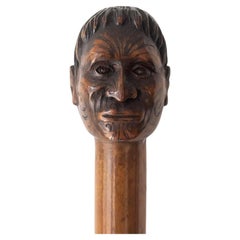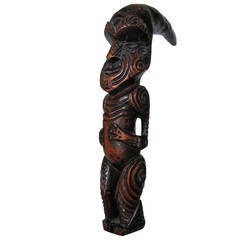Maori Walking Stick
Recent Sales
Antique 19th Century New Zealand Tribal Art
Wood
20th Century New Zealand Tribal Art
Antique Late 19th Century New Zealand Antiquities
Wood
Finding the Right Folk-art for You
Folk art refers to a genre of art that shares the creator’s traditions, offering not just an artistic display but an opportunity to learn about a culture. Vintage, new and antique folk art typically reflects a heritage or location. It can include utilitarian objects and handmade art as diverse as weather vanes, portraiture and paintings, carnival art, quilts and duck decoys.
American folk art is frequently valued because of the traditional skills involved, like weaving, hand-carving wood and even stonework. Many folk artists are self-taught, while some train as apprentices within their community. By using available materials and taking a personal approach to their creations, artists ensure each piece is unique and conveys a story. Native American folk art includes functional objects reflecting their heritage, such as baskets, textiles and wooden pieces.
During the Great Depression, artistic materials in America were hard to come by, so artisans used discarded wood from cigar boxes and shipping crates to make highly stylized, notched pieces — most often picture frames and boxes — that are today sought after by collectors. This folk art style is called tramp art and was popular from roughly 1870 until the 1940s.
Folk art brings vibrant culture and traditions into your home. Browse an extensive collection of folk art on 1stDibs.
- What is a Malacca walking stick?1 Answer1stDibs ExpertApril 5, 2022A Malacca walking stick is a long stick made out of palm trees native to Asia. People use the sticks to help them maintain their balance when walking, particularly over uneven terrain. In some cases, artisans use the sticks as umbrella poles. On 1stDibs, find a range of Malacca walking sticks.
- 1stDibs ExpertAugust 17, 2021Scottish walking sticks are also called canes. They’re typically made of wood and have a ball on one end for someone to grip.
- Do walking sticks really help?1 Answer1stDibs ExpertApril 5, 2022Yes, walking sticks are helpful for walking. Walking sticks can help maintain posture, stability and provide support as well as take some of the impact out of your lower back and knees. Shop a range of vintage and contemporary walking sticks on 1stDibs.
- 1stDibs ExpertFebruary 22, 2021There is not one consistent height for walking sticks but is instead dependent on your height and what you plan to use it for. Standing with your arms by your side, the walking stick should be 6 to 8 inches above your elbow. For climbing up steep hills, a longer stick is important.
- 1stDibs ExpertApril 5, 2022Walking sticks go by many different names. Some of them include: cane, handstaff, stave, shillelagh, crutch, alpenstock and staff. Walking sticks come in many different varieties from different staff material to unique and interesting heads, making them a desirable collectible. Find a collection of vintage and modern walking sticks on 1stDibs.
- 1stDibs ExpertFebruary 22, 2021To measure a walking stick, the base should be placed a little wider than a foot from the outside of the wearer's shoe. The handle should be at wrist crease height with the elbow slightly bent when standing upright.
Read More
A Giant Wedding Cake Has Us Looking at Portuguese Tiles in a New Light
At Waddesdon Manor, artist Joana Vasconcelos has installed a three-tiered patisserie inspired by the narrative tile work of her homeland. We take a look at the cake sculpture and how Portuguese tiles have been used in architecture from the 17th century to today.
Why Jules Chéret Was the King of the Modern Poster
The streets of fin-de-siècle Paris were set aglow with colorful poster ads, thanks to the printing techniques invented by Jules Chéret. Now, the Milwaukee Art Museum is celebrating this undersung talent in America's first solo show dedicated his exuberant works.
Why the American Flag Has Had So Many Different Star Patterns
Expert Jeff Bridgman explains the history and meaning behind the twinkling constellations that have graced Old Glory.
Peggy Guggenheim Loved Modernism, but She Also Collected Tribal Art
The iconoclastic style setter displayed African and Oceanic art, as well as works by indigenous peoples of the Americas, alongside pieces by such major modernists as Pablo Picasso and Jackson Pollock.
The 13-Star American Flag Had More Variations Than You’d Think
Perfect for July 4th weekend, a new show at Philadelphia's Museum of the American Revolution displays an array of antique red, white and blue flags.
Tramp Art, America’s Most Misunderstood Art Form, Is Trending in Interiors
Designers are beginning to see this enigmatic form of folk art in a whole new light.

